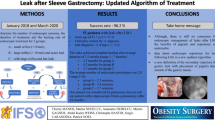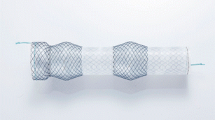Abstract
Background
Sleeve gastrectomy has become one of the main bariatric procedures over the last few years. This can be explained by the relative simplicity and high effectiveness of this method. Yet, it causes complications as any other method. Staple line leaks are the most frequent ones. According to different sources, this complication may occur with 0–7% frequency. Until 2013, surgery was the only effective treatment method for this complication. However, reoperations considerably increased treatment cost and patient morbidity. The aim of this study is to present the possibilities of endoscopic treatment of leaks after laparoscopic sleeve gastrectomy.
Methods
From 2014 to 2016 14, cases of leaks following sleeve gastrectomy were diagnosed in our Department in Łódź. All of them were treated with MEGA stent in order to cover the leak site. Due to severe peritonitis, 3 patients had to undergo surgery prior to implantation of the prosthesis. Another patient underwent an unsuccessful attempt of leak closing via OTSC method prior to implantation of the prosthesis. Patients were nourished from the 3rd day after the surgery. On average, prostheses were removed on the 34th day after the implantation.
Results
The leak was fully sealed in 13 out of 14 cases. In 10 cases the leak was fully healed. There were 2 cases of patients’ deaths: the result of a multi-organ failure in one case and early esophageal perforation in the other one. The overall success rate was 90.9%.
Conclusion
Sealing leaks occurring after sleeve gastrectomy with MEGA stents represent an effective method and should become the technique of choice.










Similar content being viewed by others
References
WHO (2015) Obesity and overweight Fact sheet No 311
Biejat Z (2009) Chirurgiczne leczenie otyłości in CHIRURGIA Noszczyk W. Wydawnictwa Lekarskie PZWL, Warszawa
Frączek M, Krawczyk M, Szmidt J, Kużdżała J (2009) Operacyjne leczenie otyłości in Postawy Chirurgii, Medycyna Praktyczna
Buchwald H, Angrisani L, Santonicola A et al (2015) Bariatric Surgery Worldwide 2013. Obes Surg 25(10):1822–1832
Sarkhosh K, Birch D, Sharma A et al (2013) Complications associated with laparoscopic sleeve gastrectomy for morbid obesity: a surgeon’s guide. Can J Surg 56(5):347–352
Southwell T, Lim T, Ogra R (2016) Endoscopic therapy for treatment of staple line leaks post-laparoscopic sleeve gastrectomy (LSG): experience from a Large Bariatric Surgery Centre in New Zealand. Obes Surg 26:1155–1162
Aurora A, Khaitan L (2012) Sleeve gastrectomy and the risk of leak: a systematic analysis of 4,888 patients. Surg Endosc 26:1509–1515
Rosenthal R (2012) International sleeve gastrectomy expert panel consensus statement: best practice guidelines based on experience of > 12,000 cases. Rosenthal Surg Obes Relat Dis 8:8–19
Tan J, Kariyawasam S, Wijeratne T et al (2010) Diagnosis and management of gastric leaks after laparoscopic sleeve gastrectomy for morbid obesity. Obes Surg 20:403–409
Corona M, Zini C, Allegritti M et al (2013) Minimally invasive treatment of gastric leak after sleeve gastrectomy. Radiol Med 118:962–970
Jahangeer B et al (2014) Mega stents: a new option for management of leaks following laparoscopic sleeve gastrectomy. Endoscopy 46:E49–E50
Nguyen N, Nguyen X, Dholakia C (2010) the use of endoscopic stent in management of leaks after sleeve gastrectomy. Obes Surg 20:1298–1292
Eubanks S, Edwards C, Fearing N et al (2008) Use of endoscopic stents to treat anastomotic complications after bariatric surgery. J Am Coll Surg 206(5):935–938
Slim R, Smayra T, Chakhtoura G et al (2013) Endoscopic stenting of gastric staple line leak following sleeve gastrectomy. Obes Surg 23:1942–1945
Donatelli G, Ferretti S, Vergeau S et al (2014) Endoscopic internal drainage with enteral nutrition (EDEN) for treatment of leaks following sleeve gastrectomy. Obes Surg 24(8):1400–1407
Author information
Authors and Affiliations
Corresponding author
Ethics declarations
Disclosures
Dr. Klimczak Tomasz, Dr. Klimczak Jerzy, Dr. Szewczyk Tomasz, Dr. Janczak Przemysław, and Dr. Jurałowicz Piotr have no conflicts of interest or financial ties to disclose.
Ethical approval
All procedures performed in studies involving human participants were in accordance with the ethical standards of the institutional and/or national research committee and with the 1964 Helsinki declaration and its later amendments or comparable ethical standards.
Informed consent
Informed consent was obtained from all individual participants included in the study.
Rights and permissions
About this article
Cite this article
Klimczak, T., Klimczak, J., Szewczyk, T. et al. Endoscopic treatment of leaks after laparoscopic sleeve gastrectomy using MEGA esophageal covered stents. Surg Endosc 32, 2038–2045 (2018). https://doi.org/10.1007/s00464-017-5900-7
Received:
Accepted:
Published:
Issue Date:
DOI: https://doi.org/10.1007/s00464-017-5900-7




